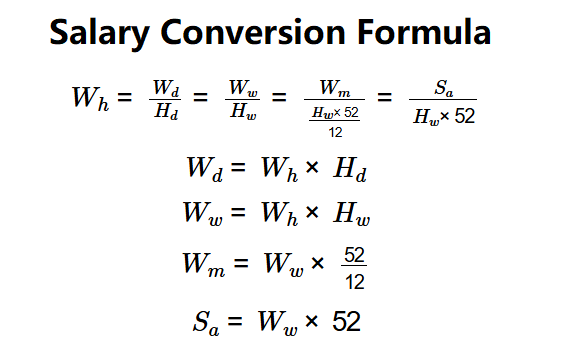1. What is the Salary Converter?
Definition: The Salary Converter calculates equivalent wages across different time periods (hourly, daily, weekly, monthly, and annual) based on hours worked per week and one known wage type.
Purpose: Helps employees, job seekers, and employers compare compensation across different pay structures for budgeting and salary negotiations in 2025.
2. How Does the Converter Work?
The converter computes wages using the following formulas, assuming 52 weeks per year and 5 working days per week:
Formulas:
\( W_h = \frac{W_d}{H_d} = \frac{W_w}{H_w} = \frac{W_m}{\frac{H_w \times 52}{12}} = \frac{S_a}{H_w \times 52} \)
\( W_d = W_h \times H_d \)
\( W_w = W_h \times H_w \)
\( W_m = W_w \times \frac{52}{12} \)
\( S_a = W_w \times 52 \)
Where:
- \( W_h \): Hourly wage ($/hour)
- \( W_d \): Daily wage ($/day)
- \( W_w \): Weekly wage ($/week)
- \( W_m \): Monthly wage ($/month)
- \( S_a \): Annual salary ($/year)
- \( H_w \): Hours per week (hours)
- \( H_d \): Hours per day (\( H_w / 5 \))
Steps:
- Step 1: Input Hours per Week. Enter the number of hours worked weekly (e.g., 40).
- Step 2: Select Wage Type. Choose one of hourly, daily, weekly, monthly, or annual wage from the dropdown.
- Step 3: Input Wage Value. Enter the known wage for the selected type.
- Step 4: Calculate Hourly Wage. Convert the input wage to hourly using the appropriate formula.
- Step 5: Calculate Other Wages. Compute daily, weekly, monthly, and annual wages from the hourly wage.
3. Importance of Salary Conversion
Converting salaries across different periods is crucial for:
- Job Comparison: Enables comparing job offers with different pay structures (e.g., hourly vs. annual).
- Financial Planning: Helps budget by understanding earnings in daily, weekly, or monthly terms.
- Negotiation: Assists in negotiating fair compensation by standardizing pay rates.
4. Using the Converter
Example:
Hours per week = 40, Wage type = Hourly, Wage value = $20:
- Step 1: \( H_w \) = 40 hours.
- Step 2: Wage type = Hourly.
- Step 3: \( W_h \) = $20.
- Step 4: \( H_d = 40 / 5 = 8 \) hours/day.
- Step 5:
- \( W_d = 20 \times 8 = 160 \).
- \( W_w = 20 \times 40 = 800 \).
- \( W_m = 800 \times \frac{52}{12} \approx 3466.67 \).
- \( S_a = 800 \times 52 = 41600 \).
- Result: Hourly wage = $20.00, Daily wage = $160.00, Weekly wage = $800.00, Monthly wage = $3466.67, Annual salary = $41600.00.
This shows equivalent earnings across periods as of July 05, 2025.
5. Frequently Asked Questions (FAQ)
Q: How do I convert an annual salary to an hourly wage?
A: Divide the annual salary by the product of hours per week and 52: \( W_h = S_a / (H_w \times 52) \). E.g., $41,600 / (40 × 52) = $20/hour.
Q: Why assume 52 weeks per year?
A: A 52-week year is standard for unadjusted salary calculations, ignoring holidays or paid time off, as per common practice.
Q: Can I include taxes in the calculation?
A: This calculator provides pre-tax wages. For after-tax estimates, use a separate tax calculator or consult local tax regulations.
 Home
Home
 Back
Back
